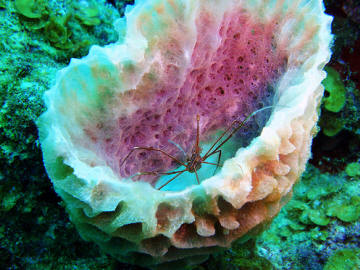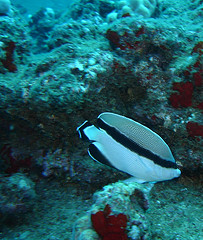Interactions
Symbiosis:
Sponges take part in wide variety of symbiotic relationships.
They have become a source of shelter for a variety of small
marine plants that take refuge in the vast porous system of the
 sponge. They have formed a mutualistic relationship with
various types of bacteria and algae as well, offering protection
for the microorganisms in exchange for an alternate source of
food and minerals. On the other hand, sponges tend to
cause some harm as well. As a source of locomotion sponges
can excavate themselves to the surface of corals or the shell of
a grown mollusk. This can often harm the receiving end of
the sponge's attachment. When the sponge attaches it
degrades the surface it rests on in order to gain a better "foot
hold." In turn, however, the shell of the mollusk or the
outer Calcium casing of the coral is degenerated and sometimes
results in the death of the host organism. On the bright
side, this can also act as an important mechanism in which the
host organism's calcium covering is recycled.
sponge. They have formed a mutualistic relationship with
various types of bacteria and algae as well, offering protection
for the microorganisms in exchange for an alternate source of
food and minerals. On the other hand, sponges tend to
cause some harm as well. As a source of locomotion sponges
can excavate themselves to the surface of corals or the shell of
a grown mollusk. This can often harm the receiving end of
the sponge's attachment. When the sponge attaches it
degrades the surface it rests on in order to gain a better "foot
hold." In turn, however, the shell of the mollusk or the
outer Calcium casing of the coral is degenerated and sometimes
results in the death of the host organism. On the bright
side, this can also act as an important mechanism in which the
host organism's calcium covering is recycled.
Predation:
To learn more about what a sponge likes to eat, please visit
the Nutritio n section of my page!
n section of my page!
Sponges tend to come in a wide variety of colors and shapes.
Their bright colors can sometimes be a sure sign of toxicity.
Many sponges use this toxicity or color to ward off possible enimies. Because of this defense mechanism, along with the
fact that sponges aren't a very nutrition mean, they do not have
many predators. However one species, Apolemichthys
arcuatus, more commonly known as the
Bandit Angelfish, has developed a way to efficiently prey on
sponges. The angelfish use their small, pointed mouths to
burrow deep into the sponge. They then use their numerous
teeth to shred the sponge into tiny pieces, gaining whatever
nutrients they can. A worthy opponent...
Return Back to Top
Continue Onward to Medicinal Uses...